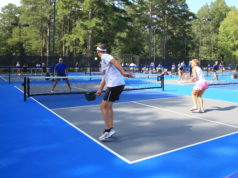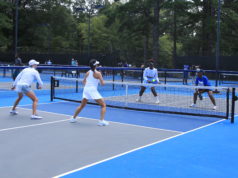By Ian Thomson, Director of Tennis, Carl E. Sanders Family YMCA at Buckhead
Every person who has ever played tennis has a weakness in their game. Yes, that means that players who make a living doing this are on the list. Many of you reading this right now are thinking of some weakness you have, and maybe are even considering calling your coach for a lesson before your next ALTA match. It is important to understand that a weakness can be turned into a strength and can be somewhat protected in matches. While there are ways to combat someone who protects their weaknesses, this article will deal with the weakness before the match, during the match, and following the match.
The most important thing to realize is what a weakness is, and how it came into existence. Common weaknesses among tennis players are the backhand and the serve for most levels of play. Part of the issue might be your coach; most pros, myself included, will be so focused on drills and strategy that we do not realize we are feeding all the balls to your forehand. Think of your last practice and see what percentage of shots started with a forehand versus a backhand; it is probably 75/25 or 80/20. You can see why there is more confidence in the forehand.
Think of something in which you are confident and think about how many times you have done this activity. The example I tell my players is to consider the route you use driving home from playing tennis. You know the route well and can take any number of alternate routes if needed. Do you have the same confidence going on a different route for the first time? Practice builds confidence. Consider how many serves you do in the team practices. While you should not spend too much time serving, would 5-10 minutes working on it be better than serving in a doubles rotation? The next time you are in a lesson, look at what is going on and ask for some backhands on the feed to begin adding to the reps. I feel a 60/40 split between your favorite shot versus your weaker shot will help build your confidence for match play.
What can you do during matches to protect the weakness? For example, since the backhand is a common shot to protect, some simple tactics might be in order. The first tactic might be in warm-up to run around your first couple of forehands and hit backhands. Then look at your partner and act as if the lightbulb turned on and start hitting forehands. This will confuse your opponents because hardly anyone runs around forehands for a backhand unless they love the shot. This will make them really have to ponder where to hit the ball. This is ethical gamesmanship and is fair so long as it isn’t taken too far. Another tactic for protecting your weak backhand is to use the Australian formation to make sure you are running to the side where you can hit more forehands. This is based on the player’s strength, but usually deuce court for right-handed players and ad court for left-handed players. If a team uses the lob, have your partner play a little deeper in the box so the lob is not a good option, which forces your opponents to hit to your forehand side.
There are many other ways to protect your weakness. Talk with your coach about how to protect during a match based on their personal knowledge of your game. If your first serve is a weakness, use your second serve as a first a few times each set so you are making more first serves. This will decrease the likelihood that your second serve will be attacked so decisively.
Once you’ve started implementing these new strategies, reflect on each match and see how well you protected your weakness. Did the opponents exploit your weakness? How do you feel about the way you played? Make some notes and discuss these with your coach. Make sure you continue to work on the weakness so it is no longer something that you will be as stressed over in a match. The last part of your post-match work is setting up a game plan on what you are going to do when you get the shot in a match. It can be that every backhand will be cross court, a lob, or a slice. It does not matter what shot you choose so long as you have a plan to take that guesswork out of the equation, which will allow you to relax during the match.
The next time you are in a lesson, make sure you take the time to analyze the breakdown of the shots you are hitting. Are you at the net all the time and neglect groundstroke work? Do you spend too much time on the baseline? All forehand feeds, or backhand feeds? Tennis professionals really want you to have a good time, so hitting your favorite shot is sometimes just an automatic reaction for your benefit. While this will make the practice a lot of fun, it will continue to leave a weakness without getting practice on it. You can work on this before the match so when you get on the court it is easier to have more confidence. Have a game plan to protect or confuse your opponent in the warm-up. And after the match, reflect on what happened so when you come to practice, you have something to discuss with your coach. The off-season is a great time to revamp the weakness with practice and take it out of the “fear zone” and into the “confidence zone.” Good luck in your matches!




